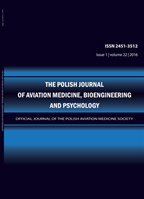2018, Volume 24, Issue 2
THE INFLUENCE OF RELAXATION TRAINING TECHNIQUES ON PILOTS’ LEVELS OF TOLERANCE TO MOTION SICKNESS SYMPTOMS DURING SIMULATED FLIGHT – PRELIMINARY RESULTS
KRZYSZTOF KOWALCZUK1, MICHAŁ JANEWICZ2, ZOFIA PRZYMUS3, TADEUSZ GRZESZUK1, ROBERT KILIAN1, STEFAN GAŹDZIŃSKI4
-------------------------------------------------------------------------------------------------
1Department of Simulator Studies and Aeromedical Training, Military Institute of Aviation Medicine
2SWPS University of Social Sciences and Humanities
3Kozminski University
4Creative Neuroscience Lab – CNS Lab, Military Institute of Aviation Medicine
Autor korenspondencyjny: MICHAŁ JANEWICZ; SWPS University of Social Sciences and Humanities; email: michal.janewicz@gmail.com
Full text
Streszczenie
Introduction: We wanted to assess whether or not relaxation techniques may be useful tools to help pilots with habituation and desensitization, and if they could be used to prevent the symptoms of motion sickness?
Methods: We have decided to use The Motion Sickness Assessment Questionnaire (MSAQ). A MiG – 29 aircraft simulator was used during the testing procedure. The Schultz Autogenic Training procedure was used for relaxation training.
Results: Statistically significant differences were found in the overall score (0,0054 p<0,05) as in some of the factors: Central (0,015 p<0,05) and Sopite-related (0,035 p<0,05). Both the remaining factors exhibited a statistical trend. All the raw scores: overall and factoral ones were lower in the second testing in comparison with the first one.
Discussion: The results show us that a simple, low time-consuming and inexpensive method can possibly be used along other training options to further expand pilots’ skills.
Słowa kluczowe
pilots, relaxation training, motion sickness, simulated flight, air force, military
